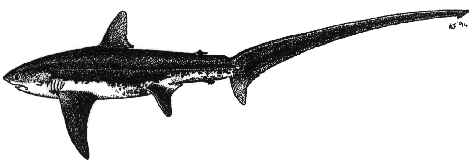Thresher shark (Alopias vulpinus)

(Bonnaterre, 1788).
| Fr |
Renard; Faucheur |
| Sp |
Zorro; Tiburon zorro blanco; Rabosa
(Catalunya); Cinturo (Balearics); Peix espasa
(Majorca) |
| It |
Squalo volpe; Pesci rattu (Liguria); Pavone
(Salerno); pesce bandiera (Rimini); Pisci cudutu (Messina)
|
| Ma |
Pixxivolpi; Budenb
|
Diagnosis
Upper lobe of caudal fin greatly elongated and tapering almost
whip-like, its length typically equi-sized or slightly exceeding
trunk length. Snout short, rounded and conical with moderately-sized
eyes that are not dorsally-expanded; labial furrows present at
corners of mouth; no grooves on the anterior dorsum above the
gills (compare with A. superciliosus). 1st dorsal fin anterior
origin above pectoral rear free tips. Colour slate-grey
dosally, with an irridescent structural sheen on the flanks of
freshly-caught examples; white ventrally, with a strong, variable
line of demarcation between the two pigments associated with
blotching typically around the pelvic fins; ventral white pigment
extends along the flanks above the pectoral fins. Undersides of
pectoral fins and pelvic fins often darkly-blotched.
Size
Maximum total length 550cm and possibly to 600cm; most
specimens typically 200 to 500cm; size at birth 114 to 150cm
TL.
Status and Distribution
Mediterranean Sea: Common or frequent. Entire western
Mediterranean to Sicily; somewhat rarer off southern Tunisia and
increasingly sporadic further east to Libya and Egypt. Sicilian
Channel and Malta Channel (sometimes locally abundant). Cosmopolitan
in the Ionian Sea, also both sides of the Adriatic where it ranges
to the northern extremes; Balkan peninsula coasts, Aegean Sea,
Turkey, Dodecanese and Cyprus; scarcer off Lebanon and Israel.
Biology
The thresher shark is an epipelagic species, both coastal and
offshore over continental slopes where it ranges from the surface
down to at least 366m. They will readily approach the shoreline
following schools of fish and penetrate shallow bays or narrow
passes between islands. In the summer months, especially in the
still conditions such as typify the northern Adriatic off Venice and
Rimini, these sharks can often be seen swimming at the surface with
their long caudal fin scything the water, apparently whilst actively
feeding upon small fish that seem to "boil" ahead of the shark.
There are reports of this species leaping clear of the surface and
it is clearly cabable of high speed dashes. Assumedly, the elongate
tail is utilised as a specialised tool for feeding, whereby the
thresher first herds and then stuns schooling fish with strong
sweeping blows. Essentially piscivorous, feeding on clupeids such as
sardines; scombroids such as mackerel; also garfish and
lanternfishes; cephalopods, octopuses, infrequently crustaceans and
even seabirds. Ovoviviparous; litter size 2 to 4; full-term pregnant
females taken off western Sicily and elsewhere; nursery-zone in
Northern Adriatic during the summer months. Females mature at
370 cm +; males at 319cm +.
The Shark Trust, 36 Kingfisher Court, Hambridge Road, Newbury, Berkshire, RG14 5SJ, UK.
Tel(+44) 01635 551150, Fax(+44) 01635
550230
|